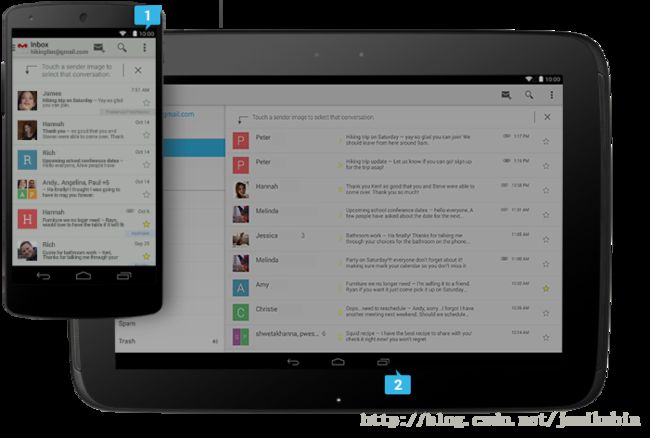Android NavigationBar中虚拟键调查
NavigationBar调查
NavigationBar是Android4.0以后出现的新特性,下图2就是NavigationBar,其中包括Back, Home, Recent键。并且对于基于2.3或者更早的版本的app,会在右下角显示一个Menu。这几个键都是虚拟的按键,对于没有实体键的手机或者tablet相当的方便。
NavigationBar的显示与隐藏
NavigationBar在App层是由SystemUI控制显示与隐藏的,并且布局文件也在SystemUI中。SystemUI在路径frameworks/base/packages/SystemUI/。
SystemUI就是StatusBar的界面部分,随系统启动而启动。SystemUI启动后会加载SystemUI/src/com/android/systemui/statusbar/phone/PhoneStatusBar.java
之后调用makeStatusBarView构建视图,其中就包括了NavigationBar的创建。代码如下:
try {
boolean showNav = mWindowManagerService.hasNavigationBar();
if (showNav) {
mNavigationBarView =
(NavigationBarView) View.inflate(context, R.layout.navigation_bar, null);
mNavigationBarView.setDisabledFlags(mDisabled);
mNavigationBarView.setBar(this);
}
} catch (RemoteException ex) {
// no window manager? good luck with that
}
可见NavigationBarView其实是NavigationBar的视图,对应的layout文件为navigation_bar.xml。NavigationBar是否构建显示是通过mWindowManagerService的hasNavigationBar()接口确定的。WindowManagerService会向下调用Policy的接口hasNavigationBar决定NavigationBar显示与否。
public interface WindowManagerPolicy {
public boolean hasNavigationBar();
}而Policy调用的实际上是PhoneWindowManager的接口hasNavigationBar,获取变量mHasNavigationBar的布尔值,这个变量是setInitialDisplaySize的时候初始化的。
public class PhoneWindowManager implements WindowManagerPolicy {
... ...
// Use this instead of checking config_showNavigationBar so that it can be consistently
// overridden by qemu.hw.mainkeys in the emulator.
public boolean hasNavigationBar() {
return mHasNavigationBar;
}
... ...
public void setInitialDisplaySize(Display display, int width, int height, int density) {
... ...
// SystemUI (status bar) layout policy
int shortSizeDp = shortSize * DisplayMetrics.DENSITY_DEFAULT / density;
String deviceType = SystemProperties.get("sys.device.type");
if (! "".equals(deviceType) && deviceType.equals("tablet")) {
// if indicate device type is tablet skip the judge for "phone" UI
} else if (shortSizeDp < 600) {
// 0-599dp: "phone" UI with a separate status & navigation bar
mHasSystemNavBar = false;
mNavigationBarCanMove = true;
} else if (shortSizeDp < 720) {
// 600+dp: "phone" UI with modifications for larger screens
mHasSystemNavBar = false;
mNavigationBarCanMove = false;
}
if (!mHasSystemNavBar) {
mHasNavigationBar = mContext.getResources().getBoolean(
com.android.internal.R.bool.config_showNavigationBar);
// Allow a system property to override this. Used by the emulator.
String navBarOverride = SystemProperties.get("qemu.hw.mainkeys");
if (! "".equals(navBarOverride)) {
if (navBarOverride.equals("1")) mHasNavigationBar = false;
else if (navBarOverride.equals("0")) mHasNavigationBar = true;
}
} else {
mHasNavigationBar = false;
}
}
}com.android.internal.R.bool.config_showNavigationBar这个才是navigationbar显示与否的配置变量,这个变量其实是在Android编译过程中由
frameworks/base/core/res/res/values/config.xml配置的
false WindowManagerPolicy -- frameworks/base/core/java/android/view/WindowManagerPolicy.java
PhoneWindowManager -- frameworks/base/policy/src/com/android/internal/policy/impl/PhoneWindowManager.java
另一方面,通过调用SystemProperties.get("qemu.hw.mainkeys");获取到NavigationBar是否被自定义,系统默认是不会设置qemu.hw.mainkeys的值的,所以获取到的是“0”。因此,就算不设定config.xml中config_showNavigationBar的值为true,屏幕够大的话,NavigationBar默认还是会显示出来的。
External/qemu/vl-android.c中如下代码会设定qemu.hw.mainkeys的值,下层代码没有继续调查。
/* Initialize presence of hardware nav button */
boot_property_add("qemu.hw.mainkeys", android_hw->hw_mainKeys ? "1" : "0");总的来说NavigationBar的显示与隐藏主要依赖3个方面
1.config.xml的配置config_showNavigationBar为true则显示,false不显示
2.Density,WXGA720/WXGA800/WXGA800-7in三种分辨率显示
3.Qemu.hw.mainkeys的设置,0显示,1不显示
NavigationBar Click事件处理
NavigationBar的layout文件是frameworks/base/packages/SystemUI/res/layout/navigation_bar.xml
视图类是Frameworks/base/packages/SystemUI/src/com/android/systemui/statusbar/phone/NavigationBarView.java
从layout文件看navigation_bar.xml是按方向配置的,rot0/rot90/rot270
每个方向都会包含KeyButtonView类型的4个View,
id分别是back/home/recent_apps/menu。
视图类NavigationBarView.java中会包含获取4个button的接口,代码如下:
public View getRecentsButton() {
return mCurrentView.findViewById(R.id.recent_apps);
}
public View getMenuButton() {
return mCurrentView.findViewById(R.id.menu);
}
public View getBackButton() {
return mCurrentView.findViewById(R.id.back);
}
public View getHomeButton() {
return mCurrentView.findViewById(R.id.home);
}SystemUI启动后会调用PhoneStatusBar.java的start->addNavigationBar()->
prepareNavigationBarView(),并在prepare中设定了recent和Home的处理事件。
@Override
public void start() {
... ...
addNavigationBar();
}
// For small-screen devices (read: phones) that lack hardware navigation buttons
private void addNavigationBar() {
if (DEBUG) Slog.v(TAG, "addNavigationBar: about to add " + mNavigationBarView);
if (mNavigationBarView == null) return;
prepareNavigationBarView();
mWindowManager.addView(mNavigationBarView, getNavigationBarLayoutParams());
}
private void prepareNavigationBarView() {
mNavigationBarView.reorient();
mNavigationBarView.getRecentsButton().setOnClickListener(mRecentsClickListener);
mNavigationBarView.getRecentsButton().setOnTouchListener(mRecentsPreloadOnTouchListener);
mNavigationBarView.getHomeButton().setOnTouchListener(mHomeSearchActionListener);
mNavigationBarView.getSearchLight().setOnTouchListener(mHomeSearchActionListener);
updateSearchPanel();
}接下来先看最简单的Recent Button。
Recent Button Click事件处理
private View.OnClickListener mRecentsClickListener = new View.OnClickListener() {
public void onClick(View v) {
toggleRecentApps();
}
};Recent button设定了onClickListener,处理函数是toggleRecentApps()。toggleRecentApps在PhoneStatusBar的父类BaseStatusBar中实现。
@Override
public void toggleRecentApps() {
int msg = MSG_TOGGLE_RECENTS_PANEL;
mHandler.removeMessages(msg);
mHandler.sendEmptyMessage(msg);
}从函数实现来看,发送了MSG_TOGGLE_RECENTS_PANEL msg给线程。
protected class H extends Handler {
public void handleMessage(Message m) {
switch (m.what) {
case MSG_TOGGLE_RECENTS_PANEL:
if (DEBUG) Slog.d(TAG, "toggle recents panel");
toggleRecentsActivity();
break;
... ...
}
}
}BaseStatusBar.java的内部线程会调用toggleRecentsActivity()处理接收到的消息。
protected void toggleRecentsActivity() {
try {
TaskDescription firstTask = RecentTasksLoader.getInstance(mContext).getFirstTask();
Intent intent = new Intent(RecentsActivity.TOGGLE_RECENTS_INTENT);
intent.setClassName("com.android.systemui",
"com.android.systemui.recent.RecentsActivity");
intent.setFlags(Intent.FLAG_ACTIVITY_NEW_TASK
| Intent.FLAG_ACTIVITY_EXCLUDE_FROM_RECENTS);
if (firstTask == null) {
if (RecentsActivity.forceOpaqueBackground(mContext)) {
ActivityOptions opts = ActivityOptions.makeCustomAnimation(mContext,
R.anim.recents_launch_from_launcher_enter,
R.anim.recents_launch_from_launcher_exit);
mContext.startActivityAsUser(intent, opts.toBundle(), new UserHandle(
UserHandle.USER_CURRENT));
} else {
// The correct window animation will be applied via the activity's style
mContext.startActivityAsUser(intent, new UserHandle(
UserHandle.USER_CURRENT));
}
} else {
Bitmap first = firstTask.getThumbnail();
... ...
ActivityOptions opts = ActivityOptions.makeThumbnailScaleDownAnimation(
getStatusBarView(),
first, x, y,
new ActivityOptions.OnAnimationStartedListener() {
public void onAnimationStarted() {
Intent intent = new Intent(RecentsActivity.WINDOW_ANIMATION_START_INTENT);
intent.setPackage("com.android.systemui");
mContext.sendBroadcastAsUser(intent,
new UserHandle(UserHandle.USER_CURRENT));
}
});
intent.putExtra(RecentsActivity.WAITING_FOR_WINDOW_ANIMATION_PARAM, true);
mContext.startActivityAsUser(intent, opts.toBundle(), new UserHandle(
UserHandle.USER_CURRENT));
}
return;
} catch (ActivityNotFoundException e) {
Log.e(TAG, "Failed to launch RecentAppsIntent", e);
}处理消息的本质其实是通过context启动一个Activity,显示RecentApp。下层调用没有继续调查。从Log中看也确实是这样
D/PhoneStatusBar( 360): mRecentsClickListener onClicked call toggleRecentApps.
I/ActivityManager( 279): START u0 {act=com.android.systemui.recent.action.TOGGLE_RECENTS flg=0x10800000 cmp=com.android.systemui/.recent.RecentsActivity} from pid 360Home/Back/Menu Button Click事件处理
其实home/back/recent/menu都是KeyButtonView类型的View,而Home/Back Button的onTouch事件其实也是在KeyButtonView中做的处理。
onTouch会判断发送过来的key_code是否合法,合法就调用sendEvent将事件发送出去。事件是通过InputManager的injectInputEvent强制插入一个事件
public boolean onTouchEvent(MotionEvent ev) {
final int action = ev.getAction();
switch (action) {
case MotionEvent.ACTION_DOWN:
... ...
case MotionEvent.ACTION_MOVE:
... ...
case MotionEvent.ACTION_CANCEL:
... ...
case MotionEvent.ACTION_UP:
final boolean doIt = isPressed();
setPressed(false);
if (mCode != 0) {
if (doIt) {
sendEvent(KeyEvent.ACTION_UP, 0);
sendAccessibilityEvent(AccessibilityEvent.TYPE_VIEW_CLICKED);
playSoundEffect(SoundEffectConstants.CLICK);
} else {
sendEvent(KeyEvent.ACTION_UP, KeyEvent.FLAG_CANCELED);
}
} else {
// no key code, just a regular ImageView
if (doIt) {
performClick();
}
}
}
}
void sendEvent(int action, int flags) {
sendEvent(action, flags, SystemClock.uptimeMillis());
}
void sendEvent(int action, int flags, long when) {
final int repeatCount = (flags & KeyEvent.FLAG_LONG_PRESS) != 0 ? 1 : 0;
final KeyEvent ev = new KeyEvent(mDownTime, when, action, mCode, repeatCount,
0, KeyCharacterMap.VIRTUAL_KEYBOARD, 0,
flags | KeyEvent.FLAG_FROM_SYSTEM |
KeyEvent.FLAG_VIRTUAL_HARD_KEY,
InputDevice.SOURCE_KEYBOARD);
InputManager.getInstance().injectInputEvent(ev,
InputManager.INJECT_INPUT_EVENT_MODE_ASYNC);
}从log看也确实是这样处理的,其中action 0代表ACTION_DOWN,1代表ACTION_UP。mCode是键值,82代表KEYCODE_MENU,3代表KEYCODE_HOME,4代表KEYCODE_BACK。具体的KeyCode和Action可以参考
http://developer.android.com/intl/zh-cn/reference/android/view/KeyEvent.html
D/KeyButtonView( 351): onTouchEvent MotionEvent = MotionEvent { action=ACTION_DOWN, id[0]=0, x[0]=40.0, y[0]=52.0, toolType[0]=TOOL_TYPE_FINGER, buttonState=0, metaState=0, flags=0x0, edgeFlags=0x0, pointerCount=1, historySize=0, eventTime=170128, downTime=170128, deviceId=0, source=0x1002 }
D/KeyButtonView( 351): sendEvent mCode = 82
D/KeyButtonView( 351): sendEvent, action = 0
D/KeyButtonView( 351): onTouchEvent MotionEvent = MotionEvent { action=ACTION_UP, id[0]=0, x[0]=40.0, y[0]=52.0, toolType[0]=TOOL_TYPE_FINGER, buttonState=0, metaState=0, flags=0x0, edgeFlags=0x0, pointerCount=1, historySize=0, eventTime=170195, downTime=170128, deviceId=0, source=0x1002 }
D/KeyButtonView( 351): sendEvent mCode = 82
D/KeyButtonView( 351): sendEvent, action = 1
E/StrictMode( 360): at android.os.StrictMode.setClassInstanceLimit(StrictMode.java:1)
D/KeyButtonView( 360): onTouchEvent MotionEvent = MotionEvent { action=ACTION_DOWN, id[0]=0, x[0]=95.0, y[0]=47.0, toolType[0]=TOOL_TYPE_FINGER, buttonState=0, metaState=0, flags=0x0, edgeFlags=0x0, pointerCount=1, historySize=0, eventTime=160035, downTime=160035, deviceId=0, source=0x1002 }
D/KeyButtonView( 360): sendEvent mCode = 3
D/KeyButtonView( 360): sendEvent, action = 0
D/KeyButtonView( 360): onTouchEvent MotionEvent = MotionEvent { action=ACTION_UP, id[0]=0, x[0]=95.0, y[0]=47.0, toolType[0]=TOOL_TYPE_FINGER, buttonState=0, metaState=0, flags=0x0, edgeFlags=0x0, pointerCount=1, historySize=0, eventTime=160137, downTime=160035, deviceId=0, source=0x1002 }
D/KeyButtonView( 360): sendEvent mCode = 3
D/KeyButtonView( 360): sendEvent, action = 1
D/KeyButtonView( 360): onTouchEvent MotionEvent = MotionEvent { action=ACTION_DOWN, id[0]=0, x[0]=74.0, y[0]=61.0, toolType[0]=TOOL_TYPE_FINGER, buttonState=0, metaState=0, flags=0x0, edgeFlags=0x0, pointerCount=1, historySize=0, eventTime=177529, downTime=177529, deviceId=0, source=0x1002 }
D/KeyButtonView( 360): sendEvent mCode = 4
D/KeyButtonView( 360): sendEvent, action = 0
D/KeyButtonView( 360): onTouchEvent MotionEvent = MotionEvent { action=ACTION_UP, id[0]=0, x[0]=74.0, y[0]=61.0, toolType[0]=TOOL_TYPE_FINGER, buttonState=0, metaState=0, flags=0x0, edgeFlags=0x0, pointerCount=1, historySize=0, eventTime=177649, downTime=177529, deviceId=0, source=0x1002 }
D/KeyButtonView( 360): sendEvent mCode = 4
D/KeyButtonView( 360): sendEvent, action = 1
